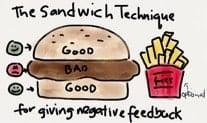
Ken Blanchard said, “Feedback is the breakfast of champions”. Breakfast is the most important meal of the day (you do know that, right?) – it provides the body and brain with fuel, energy and stamina to get through the day. In the same way, without feedback, the organization starves. Without feedback, the organization operates in a vacuum, it remains stagnant, and it cannot improve, adapt, or evolve. Feedback is the least expensive, most powerful and most effective lever for influencing behaviour. It’s also the most underused tool that managers have in their arsenal and at their disposal.
Why is feedback important? It builds trust, respect and stronger relationships between employees and managers. Feedback is a powerful course-correction tool that helps employees become aware of their blind spots and helps them understand how others perceive them. Feedback is strongly linked to employee satisfaction, engagement and productivity. It creates feelings of loyalty and commitment to the organization. It fosters accountability, facilitates learning, development, growth, retention and success.
Peter Bregman said it better than I ever could: “Giving people feedback is an act of trust and confidence. It shows that you believe in their ability to change. That you believe they will use the information to become better. And that you have faith in their potential.”
Have you heard of the “Sandwich” Model of Feedback?
It’s when a Manager gives an employee negative, constructive or corrective feedback that is “sandwiched” between two layers of (often insincere) praise.

The “benefits” of this feedback model are that it (a) softens the blow of negative or constructive feedback for the employee and (b) it’s easier and more palatable for the manager to deliver the bad news, if there’s good news to share, too.
And you know what? The Sandwich Model of Feedback really, really irritates me.
My take
The Sandwich model of feedback is a trap. You open the conversation with a sweet cup of hot tea that makes the employee feel all warm, safe and cozy. You then drop the proverbial hammer (and probably, clumsily), which causes the hot tea to spill on the employee’s lap, and then you offer the employee your hanky and a side-hug to take the sting out of the burn.
Research suggests that that managers should deliver more positive than negative feedback (and the magic ratio seems to be 5:1) – five positive feedback interactions for every negative feedback interaction – but this doesn’t mean that they have to be delivered at the same time (<insert heavy sigh>)
The Sandwich model of feedback is confusing, murky, grey and wholly ineffective. The employee often leaves the conversation feeling confused as to whether they just got a pat on the back or kicked in the teeth by his or her manager. Or worse, the employee walks out of the meeting thinking that he or she is a rock star who walks on rainbows and rides on unicorns because the negative or constructive feedback was buried in the conversation that was peppered with compliments. Managers tend to spend more time on the praise part of the conversation than the constructive feedback part of the conversation – because it’s easier, and smiles are easier to stomach than tears. How can an employee be expected to improve if he or she doesn’t have full transparency on the areas for development?
The Sandwich method of feedback helps no one. It doesn’t help the employee grow, develop and become a more productive or insightful employee. It doesn’t strengthen the relationship and bond between the manager and the employee if the employee sees the “praise” part of the sandwich from the manager as insincere, gratuitous or disingenuous. If anything, the relationship will suffer by way of loss of trust and respect. And it doesn’t help the manager become a better manager – one who is equipped with the tools he or she needs to be able to have clear, concise, difficult conversations, and one who supports the growth and development of his or her employees. So, have the courage to lose the “bread”, and go gluten free when it comes to delivering negative, constructive or corrective feedback.
Giving feedback is an art, a science and an essential management and leadership skill. When a Manager needs to deliver negative, constructive or corrective feedback to an Employee, it is essential that:
- the conversation is open, honest, clear and direct
- it builds the relationship up rather than breaks it down
- it is done with compassion and kindness, but without muddying the message
- it is delivered with empathy (by putting themselves in the employee’s shoes) and positive intent (for improvement and to help the employee grow and develop, rather than to put the employee down)
If you need some support in developing skills related to giving and receiving feedback, Salopek & Associates can help you! Contact us today!

